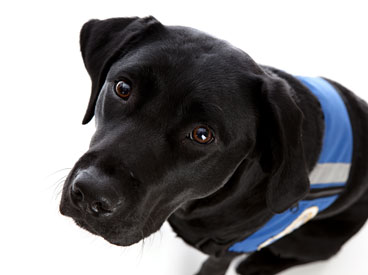Devra Lee Fishman’s dear friend and college roommate, Leslie, died from breast cancer one month shy of her 46th birthday after a four-year battle with the disease. Being with Leslie and her family at the end of her life inspired Devra to help care for others who are terminally ill. Each week, she documents her experiences volunteering at her local hospice in her blog, Hospice Girl Friday.
My brother and sister-in-law are raising Hazel, a six-month old black Lab, for the Guide Dog Foundation. Part of her early training involves socializing her in as many public settings as possible, so I asked if I could take Hazel to the hospice with me. My brother was confident Hazel would easily transition from carefree puppy to serious ‘working’ dog when she had on her yellow training vest, but I wondered how she would respond to the smells, sounds, and sights of the hospice and how the people there would respond to her.
As soon as Hazel and I walked into the hospice I introduced her to the staff. They greeted Hazel with wide smiles and high, breathy voices like they were talking to an adorable toddler.
“How are the patients today?” I asked.
“The woman in room two is a pickle,” the doctor replied, rubbing Hazel’s neck.
“A pickle?”
The doctor looked up. “You know, sometimes sweet and sometimes sour?”
“And today?”
“Sour,” the doctor replied. “She has been cranky with all of us. We were just talking about what else we might try.”
One of the nurses said, “She’s eating her breakfast now, but when she’s done do you think she could meet Hazel? Apparently she had three dogs when she was younger so Hazel might cheer her up.”
I did not plan to take Hazel to visit patients yet, but since the nurse asked I said, “Sure, just let me know when.”
I sat down at the desk and looked at the census. The ‘pickle’ was Dr. Ellen Kaye. 89 years old. Cardiovascular Disease.
Twenty minutes later the nurse approached me. “Dr. Kaye is ready and very excited,” she said.
I took hold of Hazel’s leash and told her we were going to meet Dr. Kaye. Hazel walked next to me with her head high and determined, like she knew this was important. I knocked on the door of room two and walked in. Dr. Kaye was sitting straight up in a chair next to the window with her hands flat on her lap and her eyes open wide, full of expectation. Her full-length bathrobe matched Hazel’s glossy black coat. Hazel started to tug me forward so I reminded her she was working. Hazel sat down next to Dr. Kaye and looked up at her as if to say ‘It’s okay, you can pet me now.’
Dr. Kaye leaned forward and stroked Hazel’s head.
“Your nurse said you had Weimaraners,” I said to get us started.
“Yes, three,” she said. “My dogs were the first to come over from Germany after WWII ended. They followed me everywhere. They do that, you know, Weimaraners.”
Dr. Kaye kept petting Hazel and looked up at me as she talked about her career, her many homes, and her travels. She told me her husband died of cancer almost 50 years ago and that she has lived alone ever since. She wished she could have a dog, but she knew she would not be able to take proper care of one. The whole time we talked Dr. Kaye’s eyes were bright and focused, her face animated. Occasionally she would pause to catch her breath, but other than that I could not detect any signs that her heart was failing. Nor did I see any of the sour pickle the doctor had described.
I have seen family members bring in patients’ dogs to visit, and I have always been aware of the many ways dogs can help calm and comfort people who are going through some sort of trauma. This was the first time I witnessed it first hand. I wondered how the nurse knew this might happen.
“I am sorry to interrupt,” I heard the doctor said from the doorway, “but I need to do a quick exam.” I glanced at the clock. Dr. Kaye and I had been talking for over forty-five minutes.
“Okay,” I said. Then I turned to Dr. Kaye. “Hazel and I will be here until noon. Ring your call bell if you’d like us to come back for another visit.”
“Thank you, dear,” she said. Then she smiled and leaned down to kiss the top of Hazel’s head.
The doctor found me as soon as she left Dr. Kaye’s room. “Devra, what you and Hazel did for Mrs. Kaye worked better than everything else we’ve tried. I had no idea how she would react, but her physical and mental demeanor brightened, which made it easier for us to take care of her. Thank you so much.” Then she looked down at Hazel and said, “Thank you, too, Hazel.”
Hazel locked eyes with the doctor, sat up a little straighter and wagged her tail, already looking like the professional service dog she is destined to become.
Every week I marvel at the way the hospice staff take care of their patients. I see them worry when traditional methods and medications are not effective, so I was happy to be a part of this week’s success story, especially since I originally thought going to the hospice would simply be good training for Hazel. The nurses seemed to think that Hazel could help some of the more difficult patients, and their instincts turned out to be right. Once again I drove home grateful for the privilege to watch them do anything and everything they could to make our hospice patients comfortable.
Previous post: Putting The Patient First Next post: The Things I Never Knew
Become a Saturday Evening Post member and enjoy unlimited access. Subscribe now




Comments
Debra I thoroughly enjoyed reading about your work with Hazel. Animals are so smart, kind, trusting and most of all, giving of themselves. This was a great example of what they can do for people when
nothing else seems
possible. Keep up the great
work! 🙂
Devra, it was such a delight to see you at hospice on Christmas day when my family stopped in. I had told my husband about your dog therapy…not just to the pts but to the nurses….me!!!. As you know, I am struggling to learn the fine art of hospice nursing and I am aware that the volunteers have a profound role to play in the healing process there….esp the 4 legged ones.
Thanks for sharing your sacred moments with us all. Look forward to reading more.
Dixcy